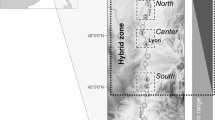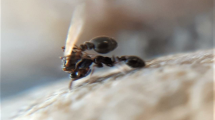Abstract
Sexual reproduction can lead to major conflicts between sexes and within genomes1,2,3,4. Here we report an extreme case of such conflicts in the little fire ant Wasmannia auropunctata. We found that sterile workers are produced by normal sexual reproduction, whereas daughter queens are invariably clonally produced. Because males usually develop from unfertilized maternal eggs in ants and other haplodiploid species, they normally achieve direct fitness only through diploid female offspring. Hence, although the clonal production of queens increases the queen's relatedness to reproductive daughters, it potentially reduces male reproductive success to zero. In an apparent response to this conflict between sexes, genetic analyses reveal that males reproduce clonally, most likely by eliminating the maternal half of the genome in diploid eggs. As a result, all sons have nuclear genomes identical to those of their father. The obligate clonal production of males and queens from individuals of the same sex effectively results in a complete separation of the male and female gene pools. These findings show that the haplodiploid sex-determination system provides grounds for the evolution of extraordinary genetic systems and new types of sexual conflict.
This is a preview of subscription content, access via your institution
Access options
Subscribe to this journal
Receive 51 print issues and online access
$199.00 per year
only $3.90 per issue
Buy this article
- Purchase on Springer Link
- Instant access to full article PDF
Prices may be subject to local taxes which are calculated during checkout



Similar content being viewed by others
References
Hamilton, W. D. Extraordinary sex ratios. Science 156, 477–488 (1967)
Eberhard, W. G. Evolutionary consequences of intracellular organelle competition. Q. Rev. Biol. 55, 231–249 (1980)
Hurst, L. D. Intragenomic conflict as an evolutionary force. Proc. R. Soc. Lond. B 248, 135–140 (1992)
Pomiankowski, A. in Levels of Selection in Evolution (ed. Keller, L.) 121–152 (Princeton Univ. Press, Princeton, 1999)
Hölldobler, B. & Wilson, E. O. The Ants (Springer, Berlin, 1990)
Torres, J. A., Snelling, R. R. & Canals, M. Seasonal and nocturnal periodicities in ant nuptial flights in the Tropics (Hymenoptera: Formicidae). Sociobiology 37, 601–626 (2001)
Sherman, P. W., Seeley, T. D. & Reeve, H. K. Parasites, pathogens, and polyandry in social Hymenoptera. Am. Nat. 131, 602–610 (1988)
Crozier, R. H. & Page, R. E. On being the right size: male contributions and multiple mating in social Hymenoptera. Behav. Ecol. Sociobiol. 18, 105–115 (1985)
Cole, B. J. & Wiernasz, D. C. The selective advantage of low relatedness. Science 285, 891–893 (1999)
Pearcy, M., Aron, S., Doums, C. & Keller, L. Conditional use of sex and parthenogenesis for worker and queen production in ants. Science 306, 1780–1783 (2004)
Baudry, E. et al. Whole-genome scan in thelytokous-laying workers of the Cape honeybee (Apis mellifera capensis): central fusion, reduced recombination rates and centromere mapping using half-tetrad analysis. Genetics 167, 243–252 (2004)
Koeniger, N., Hemmling, C. & Yoshida, T. Drones as sons of drones in Apis mellifera. Apidologie (Celle) 20, 391–394 (1989)
Cook, J. M. & Crozier, R. H. Sex determination and population biology in the Hymenoptera. Trends Ecol. Evol. 10, 281–286 (1995)
Simon, J.-C., Delmotte, F., Rispe, C. & Crease, T. Phylogenetic relationships between parthenogens and their sexual relatives: the possible routes to parthenogenesis in animals. Biol. J. Linn. Soc. 79, 151–163 (2003)
Normark, B. B. The evolution of alternative genetic systems in insects. Annu. Rev. Entomol. 48, 397–423 (2003)
Werren, J. H., Nur, U. & Eickbush, D. An extrachromosomal factor causing loss of paternal chromosomes. Nature 327, 75–76 (1987)
Nur, U., Werren, J. H., Eickbush, D. G., Burke, W. D. & Eickbush, T. H. A ‘selfish’ B chromosome that enhances its transmission by eliminating the paternal genome. Science 240, 512–514 (1988)
Ulloa-Chacon, P. & Cherix, D. Quelques aspects de la biologie de Wasmannia auropunctata (Roger) (Hymenoptera, Formicidae). Actes Colloq. Insectes Sociaux 4, 177–184 (1988)
Rice, W. R. Sexually antagonistic male adaptation triggered by experimental arrest of female evolution. Nature 381, 232–234 (1996)
Swanson, W. J., Yang, Z., Wolfner, M. F. & Aquadro, C. F. Positive Darwinian selection drives the evolution of several female reproductive proteins in mammals. Proc. Natl Acad. Sci. USA 98, 2509–2514 (2001)
Arnqvist, G. & Rowe, L. Antagonistic coevolution between the sexes in a group of insects. Nature 415, 787–789 (2002)
Helms-Cahan, S. & Keller, L. Complex hybrid origin of genetic caste determination in harvester ants. Nature 424, 306–309 (2003)
Parker, J. D. A major evolutionary transition to more than two sexes? Trends Ecol. Evol. 19, 83–86 (2004)
Chapuisat, M. Mating frequency of ant queens with alternative dispersal strategies, as revealed by microsatellite analysis of sperm. Mol. Ecol. 7, 1097–1105 (1998)
Fournier, D. et al. Characterization and PCR multiplexing of polymorphic microsatellite loci for the invasive ant Wasmannia auropunctata. Mol. Ecol. Notes 5, 239–242 (2005)
Raymond, M. & Rousset, F. GENEPOP (version 1.2): population genetics software for exact tests and ecumenicism. J. Hered. 86, 248–249 (1995)
Page, R. D. M. TreeView: an application to display phylogenetic trees on personal computers. Comput. Appl. Biosci. 12, 357–358 (1996)
Acknowledgements
We are grateful to the Laboratoire Environment de Petit Saut (EDF-CNEH) for hosting us during field work, the Centre de Coopération Internationale en Recherche Agronomique pour le Développement (CIRAD) of French Guiana for allowing access to plantations, S. Aron for performing flow cytometry analysis, and M. Chapuisat, P. Christe, D. Haig, R. Hammond, S. Helms Cahan, K. Parker and D. Queller for comments on the manuscript. The work was supported by grants from the French Ministère de l'Écologie et du Développement Durable to A.E. and the Swiss NSF to L.K.
Author information
Authors and Affiliations
Corresponding authors
Ethics declarations
Competing interests
Reprints and permissions information is available at npg.nature.com/reprintsandpermissions. The authors declare no competing financial interests.
Rights and permissions
About this article
Cite this article
Fournier, D., Estoup, A., Orivel, J. et al. Clonal reproduction by males and females in the little fire ant. Nature 435, 1230–1234 (2005). https://doi.org/10.1038/nature03705
Received:
Accepted:
Issue Date:
DOI: https://doi.org/10.1038/nature03705
This article is cited by
-
A crazy ants’ crazy form of reproduction: Causes and consequences
Journal of Biosciences (2024)
-
Impact of invasive little fire ants Wasmannia auropunctata on rainforest soil fauna: implications for conservation of the endangered flightless kagu of New Caledonia
Biological Invasions (2022)
-
Bridgehead effect and multiple introductions shape the global invasion history of a termite
Communications Biology (2021)
-
Worker ants promote outbreeding by transporting young queens to alien nests
Communications Biology (2021)
-
What mechanistic factors affect thelytokous parthenogenesis in Apis mellifera caponises queens?
Apidologie (2020)
Comments
By submitting a comment you agree to abide by our Terms and Community Guidelines. If you find something abusive or that does not comply with our terms or guidelines please flag it as inappropriate.



